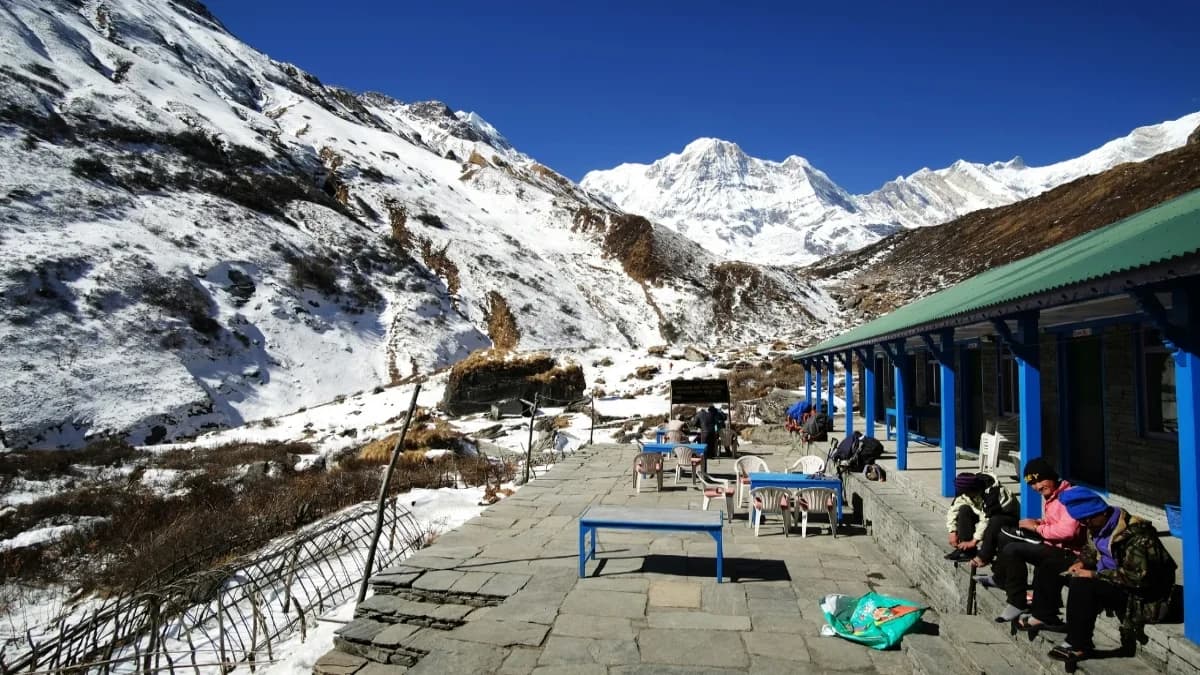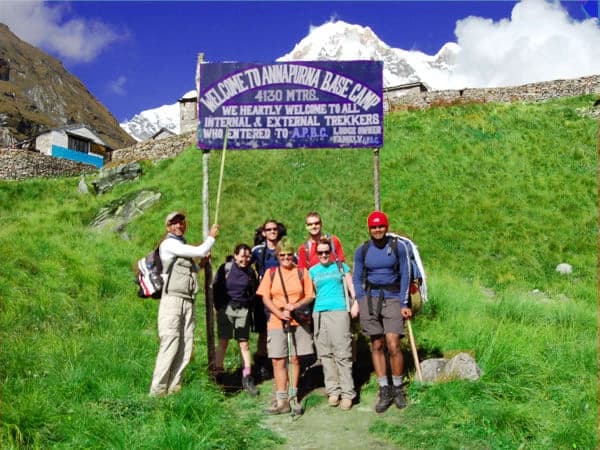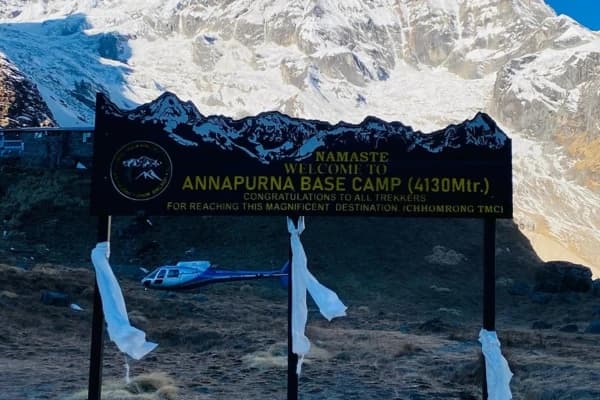Snow-covered trails, peaceful villages, and shining peaks - that is what the Annapurna Base Camp trek in January feels like. The air is crisp, mornings are quiet, and the mountain views are incredibly clear after fresh snowfall. It is colder and harsher than other months, but the calm beauty and off-season charm make it special.
If you’ve ever wondered whether you can trek to Annapurna Base Camp in January, this guide covers everything - weather, temperature, views, gear, costs, and winter tips.
Thinking about a peaceful trek with fewer crowds? January might surprise you - Stick with Nepal Gateway Trekking to see why.
Views You’ll See on the Annapurna Base Camp Trek in January
In January, the Annapurna region looks completely different. The trail runs through frosty terraced fields, icy rivers, and snow-filled pine forests. Every turn shows something special - from frozen waterfalls to the wide view of the Annapurna range.
What are the scenic views on the ABC trek in January?
- Snow-covered Gurung villages and forest paths
- Frozen waterfalls and crystal-clear streams
- Frost-covered terraces that shine in the morning light
- The Machhapuchhre and Annapurna peaks glowing during sunrise
- View of the Mardi Khola River flowing below the snowy ridges
Sunrise and Sunset View in January:
Sunrise colors the peaks in pink and gold, especially Machhapuchhre (Fishtail). Evenings bring orange light fading behind the Annapurna walls. The skies are clear, so photographers get perfect shots all day.
Peaks You’ll See on the Route
As you walk higher, you’ll see several famous peaks from different spots on the trail. Each one stands out in the crisp winter air.
- Annapurna I (8,091 m): The highest in the range and the main view from Base Camp.
- Hiunchuli (6,441 m): Seen behind Chhomrong, glowing in morning sun.
- Machhapuchhre / Fishtail (6,993 m): Sharp, beautiful, and sacred - it stands out from every point.
- Gangapurna (7,455 m): A broad snowy peak seen from Deurali and Machhapuchhre Base Camp.
If you’re short on time, try the Short Annapurna Base Camp Trek - it gives the same amazing views in fewer days.
ABC Trek Weather in January: How Cold is Annapurna Base Camp in January?
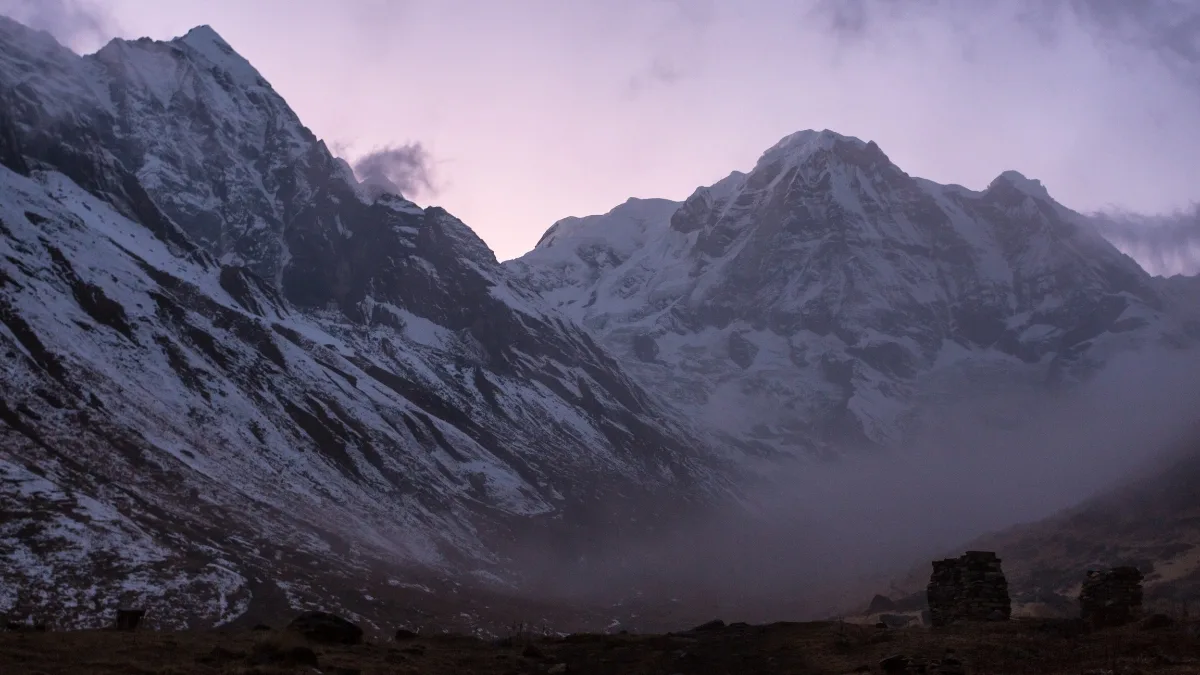
Can you do ABC trek in January? Many ask this question, and the short answer is yes. Given that January is the coldest month in the Annapurna region. You can still trek. Just be careful of your surroundings and the weather. Mornings start icy, and nights drop well below zero. The air is dry, and the skies are clear most of the time, which means great views but freezing nights.
Here’s a look at what to expect:
|
Location |
Approx. Altitude (m) |
Approx. Day Temp (°C) |
Approx. Night Temp (°C) |
Typical Weather Conditions |
|
Pokhara |
~827 |
10 °C to 15 °C |
0 °C to 5 °C |
Clear skies, cold mornings/evenings |
|
Chhomrong |
~2,170 |
8 °C to 12 °C |
−2 °C to 0 °C |
Cold and dry mid-altitude region |
|
Deurali |
~3,200 |
0 °C to 5 °C |
−5 °C to −10 °C |
Snow likely, icy conditions from here upward |
|
Annapurna Base Camp |
~4,130 |
−2 °C to +2 °C |
−10 °C to −20 °C |
Heavy snow, freezing nights, high altitude risk |
Snowfall is common above 3,000 meters. Most trekkers start early, around 6 or 7 a.m., since daylight fades fast.
If you prefer mild temperatures and blooming trails, the Annapurna Base Camp Trek in May is another great option.
Why Trek Annapurna Base Camp in January?
Even though it’s cold, January has its own charm. You get to walk in peace, see the mountains at their clearest, and enjoy moments of stillness that are rare in peak season.
Top 5 Reasons to Trek ABC in January:
- Fewer crowds - quiet trails and peaceful lodges.
- Crystal-clear mountain views after snowfall.
- Cheaper flights, rooms, and permits in the off-season.
- Rare photo chances - frozen waterfalls and snow-covered paths.
- Warm cultural encounters with locals during slower travel months.
If you want a calm trekking experience and snow-white landscapes, January is your month.
Challenges of the Annapurna Base Camp Trek in January
Trekking in January is beautiful but comes with challenges. Cold and snow make it harder than usual, especially above Deurali.
- Extremely cold temperatures and snow blockage
- Icy trails that can be slippery
- Closed teahouses in higher areas
- Risk of altitude sickness due to shorter daylight hours
- Limited sunlight for hiking
Tip: Avoid solo trekking and hire a local guide familiar with winter routes. They know which paths are open and safest.
How Difficult Is the Annapurna Base Camp Trek in January?
The distance stays the same, but the snow, ice, and cold make the trek more demanding. With warm clothes, careful walking, and the right gear, it is still possible for regular trekkers. Train by taking long walks or stair-climbing before your trek. It helps your stamina and balance on icy trails.
|
Factor |
October |
January |
Difference |
|
Temperature |
Moderate |
Very Cold |
−10 °C drop |
|
Trail |
Clear |
Snow-covered |
Slippery |
|
Teahouse Availability |
Full |
Limited |
Less crowd |
|
Difficulty Level |
Medium |
Hard |
Higher |
What to Pack for Annapurna Base Camp in January?
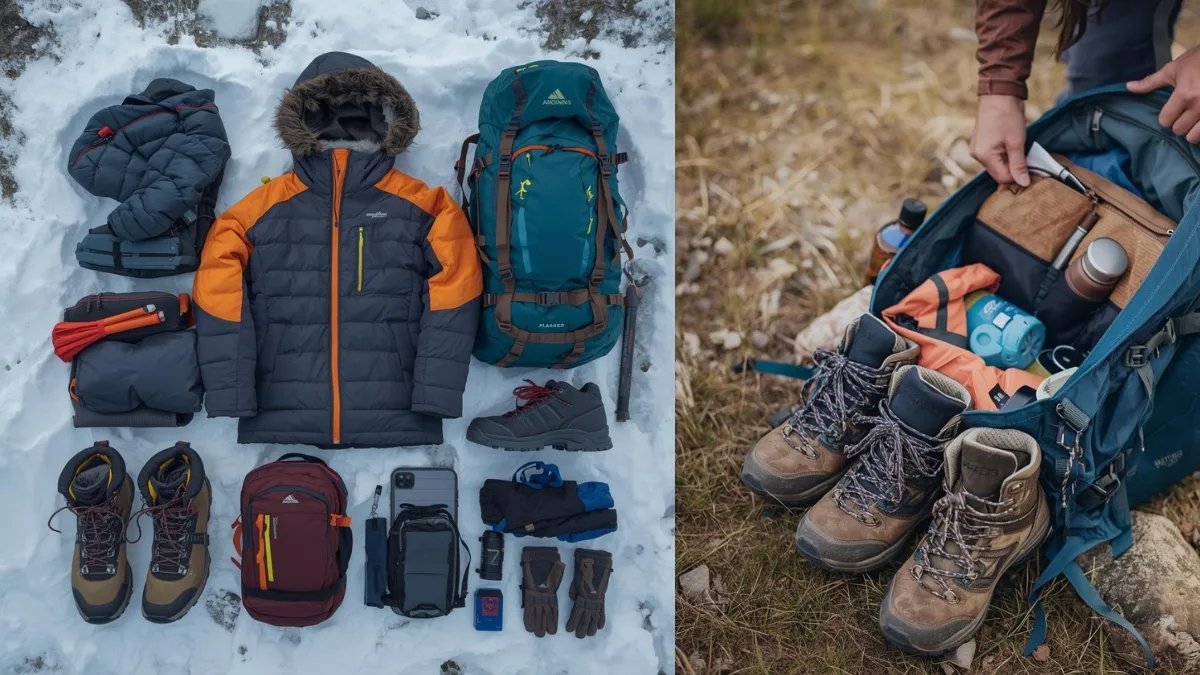
Packing right is the key to a safe winter trek. As a trekker, your main goal is to stay warm and dry without carrying too much.
Clothing layers:
- Fleece or wool mid-layer
- Down jacket and waterproof shell
- Thermal inner wear
- Warm hat, gloves, and neck gaiter
Trekking gear:
- Crampons or microspikes
- Trekking poles
- Waterproof boots
Personal items:
- Sleeping bag rated to −10 °C
- Sunscreen and lip balm
- Water bottle and thermos
- Power bank
Emergency supplies:
- First aid kit
- Headlamp
- Travel insurance papers
See our detailed guide on What to Pack for Annapurna Base Camp for a full list of winter trekking gear.
Safety Tips for Trekking to Annapurna Base Camp in January
Winter trekking means extra care. The cold, ice, and shorter days can be managed easily with good habits. Staying alert and listening to local advice keeps you safe on the trail.
Top Safety Tips for Annapurna Base Camp Trek in January:
- Take rest days for acclimatization.
- Drink plenty of water even in the cold.
- Eat warm food like soup and dal bhat.
- Keep your fingers and toes covered.
- Hire a guide or porter who knows winter shortcuts.
- Always carry travel insurance with rescue coverage.
Accommodation and Food During January
 Teahouses stay open in most villages below Deurali. Higher ones may close if snowfall is heavy. Rooms are basic but warm, with blankets and common dining halls.
Teahouses stay open in most villages below Deurali. Higher ones may close if snowfall is heavy. Rooms are basic but warm, with blankets and common dining halls.
You’ll eat simple, filling food like dal bhat, noodles, soups, pancakes, and tea. Hot meals and drinks are the best way to keep your energy up. Wi-Fi and charging are available in lower areas, but expect limited power in the higher parts.
Permits and Costs for Annapurna Base Camp Trek in January
You’ll need two permits to enter the region:
- TIMS Card (Trekkers’ Information Management System)
- ACAP Permit (Annapurna Conservation Area Project)
Here’s the average cost breakdown for a winter trek:
|
Item |
Estimated Cost (USD) |
|
ACAP Permit |
30 |
|
TIMS Card |
20 |
|
Guide (per day) |
25 - 35 |
|
Porter (per day) |
20 - 25 |
|
Food and Lodging |
25 - 35 per day |
|
Transport (Pokhara - Nayapul - Pokhara) |
20 - 30 |
Since it’s off-season, many teahouses and guides offer discounts. Sharing a guide or room also helps save money.
Final Thoughts: Should You Trek to Annapurna Base Camp in January?
The Annapurna Base Camp Trek in January is quiet, cold, and magical. Snow adds both beauty and challenge, but the clear skies and calm trails make every step worth it.
If you prepare well, pack right, and go with a local guide, it’s a safe and memorable adventure.
Want to experience winter in the Himalayas? Contact Nepal Gateway Trekking to plan your January trekking in Nepal safely and comfortably.
FAQs: Annapurna Base Camp Trek in January
Is it safe to trek Annapurna Base Camp in January?
Yes, it is safe if you plan well and trek with a guide. The trail remains open, but you’ll be facing snow and icy paths at higher points.
How cold does it get at Annapurna Base Camp in January?
It can get freezing at night, often dropping between –10°C and –20°C at the base camp. Daytime is warmer, around 0°C to 5°C, but still chilly.
Can beginners trek Annapurna in January?
Beginners can do it if they are fit, patient, and well-prepared. The trek doesn’t need mountaineering skills, but winter adds extra challenges like snow, cold, and shorter daylight hours.
Are guides available in January?
Yes, guides and porters work year-round. In January, having one is even more helpful since trails may be covered in snow, and some lodges can be closed.
What is the best time for ABC trek for each day?
Start early, around 7 AM, when the skies are clear and the sunlight is soft. Afternoon weather can change fast, with cold winds or light snow.
What permits are required for the ABC trek in January?
You’ll need two main permits: the Annapurna Conservation Area Permit (ACAP) and the TIMS card. Both can be obtained in Kathmandu or Pokhara before starting the trek.
Are teahouses open during January?
Most teahouses at lower altitudes stay open, but some higher up, like in Deurali or ABC, may close if snow is heavy. Your guide will know which lodges are operating.
How long does the trek take in January?
It usually takes around 7 to 10 days, depending on your pace and the weather. Snow or ice can slow you down, so add an extra day or two as a buffer.
What should I pack for a January trek to ABC?
Pack warm clothes like thermals, a down jacket, waterproof gloves, and thick socks. Bring trekking poles, crampons, and a sleeping bag rated for –10°C or lower.
What are the risks of trekking in snowfall or icy conditions?
The main risks in snowfall and icy conditions are slipping on ice, getting caught in snowstorms, and suffering from cold-related conditions, possibly frostbite or hypothermia. Always check weather forecasts, move carefully on frozen paths, and avoid trekking alone.
